 There are many ant species that are pests and, thankfully, we have a range of options to treat them.
There are many ant species that are pests and, thankfully, we have a range of options to treat them.
The first part of any treatment must be an inspection including identification of the ant species present, checking areas of activity and locating moisture sources. The choice of treatment should be assessed taking into account the species, where they are, the impact they are having and the expectation of the customer.
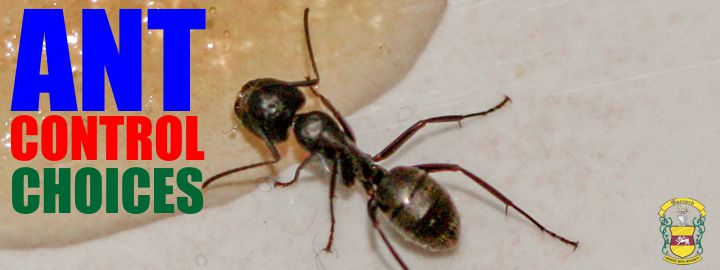
The identification of the pest species can make treatment choices easy – the stinging green-headed ant found in north-east NSW and Queensland is easily controlled overnight by a protein/oil bait – or very difficult – an infestation of Argentine ant in Melbourne is likely to be an on-going problem. In both cases the choice of treatment(s) can define the (lack of) success of the treatment. If the ant species is established within the structure, simply killing foraging workers is unlikely to provide relief because only about 5% of the ants will be foraging and exposed to any treatment.
All pest managers should carry an array of products to treat ants. The most effective way to control ants in and around structures is to locate and directly treat all nests located in and around the structure. Unfortunately, this is seldom possible. Relying on one treatment-for-all ants and situations is courting recalls. For example, it is wise to carry several types of baits in case the ant responds to sugar or protein/fat bases.
The formulations available for ant treatments include:
Sprays - the old mainstay, used mainly for broad application outdoors and perimeter treatments
Granules - granules are easy to spread over large areas but must be activated by watering in or rain.
Dusts - for use inside buildings aimed into cracks and crevices and at nests
Liquid/gel baits - based on sugar for sugar feeders, may be used in stations.
Granular baits - protein and oil based baits, more commonly used on predatory outdoor species
Sprays
The organophosphates and synthetic pyrethroids were the backbone of ant treatments for many years. However these created barriers compared to newer products which are capable of being transferred back to, and killing the entire nest.
Some of these newer non-repellent products are:
Fipronil (Termidor) – apply as a barrier treatment (300mm up and out from the wall). Also apply to ant trails and nests and where ants are active away from the nest. For use outside only.
Indoxacarb (Arilon) – treat areas of infestation and building entry points, around the perimeter and in garden beds. May provide up to 6 months control.
Chlorfenapyr (Phantom) – apply directly to foraging ants as a coarse, low pressure surface spray inside buildings. For use inside only.
INSIDE – insecticides can be used, as either the main method or as a supplement to baiting. Particle sprays (WP, SC and CS formulations) will give superior residual control on porous surfaces compared to emulsions (EC and EW formulations). Non-repellent actives should be used near areas that are baited.
OUTSIDE – drenching nests in soil often gives very effective control. Residual insecticide should be applied to exterior surfaces of walls, doors, window sills, other entry points and the perimeter of the structure. Particle sprays are more effective on most exterior surfaces, while emulsions and granule formulations are more effective for soil treatment.



Granule treatments – must be watered in to activate the chemical.
Fipronil (Impede) – treatment of funnel ants in turf.
(SAS Pro) – treatment of funnel ants and nuisance ants in turf, parks and gardens.
Bifenthrin (Brigade G) – broadcast uniformly where specified pest ants are active and to nests in turf and surrounds of buildings.
Chlorpyrifos (Ant Killer 50) – sprinkle granules lightly and evenly around nests and trails wherever ants are active outside around gardens and houses and other buildings.
Granules are most suited as soil treatments and may be distributed using a Rega Granule Puffer or spreader.

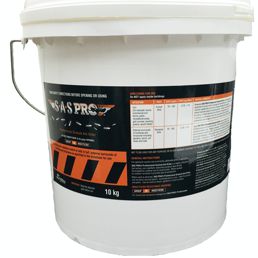


Dusts
Permethrin (Coopex, Dragnet) – apply powder along runs, on and around nests.
Applications of dusts into the nest area can rapidly eliminate the entire colony. Dusts should be applied into all crack and crevices a metre either side of where ants are seen and into voids where colony activity is suspected.
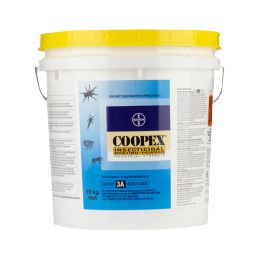

Liquid baits
Boron (Exterm-an-Ant) – place a small quantity where ants are tracking at several locations until no more ants are attracted.
Imidacloprid (Antmaster & Maxforce Quantum) - Place bait at intervals along ant trails and/or where ants are active and where they will not be disturbed or contaminated by cleaning or work activities.
Liquid baits are prone to drying out, especially outdoors and in air conditioned rooms, and to contamination from cleaning products and repellent insecticides. To overcome these problems, increase longevity of the bait and allow application of the bait difficult surfaces (eg verticals, porous etc) the bait should be placed in Rega Ant Liquid Stations or Ant Cafes.
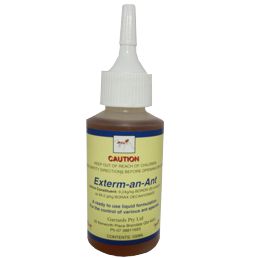
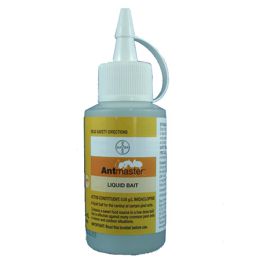

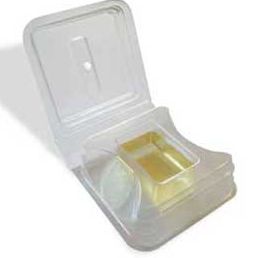
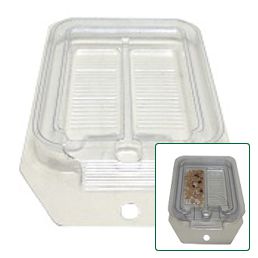
Gel baits
Indoxacarb (Advion AG) – place next to active foraging trails, nest sites or to areas known to be active without disrupting the natural foraging behaviour of the ants. Use for sugar-feeding ants.
Thiamethoxam (Optigard AG) – Place bait along ant trails and other locations where ants are most active. For outside use, place spots in protected cracks and crevices or use refillable bait stations. Use for sugar feeding ants.
Fipronil (Ant-Rid Stations) – place station indoors next to ant trails or close to areas where ants are numerous. Use for sugar and protein feeding ants.
As with liquid baits, gel baits can be protected in Rega Gel Bait Stations.
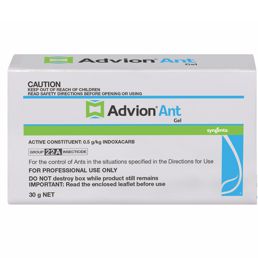
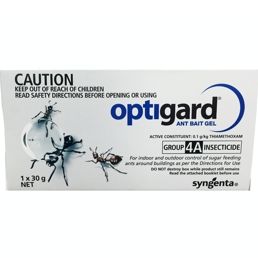
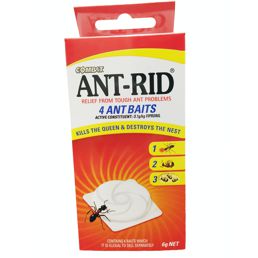
Granular baits
Hydramethylnon (Amdro) – evenly distribute granules over the infested area or near nests. Use for ants attracted to proteins – these are normally scavenging ants.
(Maxforce Complete) – sprinkle evenly as a barrier or over an area where ants are active avoiding direct application to nests. Ants are usually most active in the late afternoon.
Pyriproxifen (Distance Plus) – best applied in the early spring or summer at the first sign of ant activity. Application is most effective when ants are actively foraging. The foraging ants take the bait back to the nest where it prevents the queen from laying viable eggs becoming workers and reproductives.
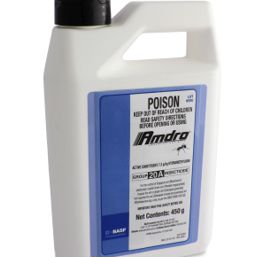

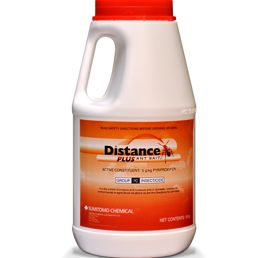
Using baits
Bait effectiveness will be optimised if other possible sources of food are eliminated. Have available a few different types of bait – some ants prefer sugar-based baits, others proteins and/or oils. Try a small amount of the various baits to test which they are attracted to. Use sufficient number of baiting points to maximise bait uptake. The greater the number of baiting points the greater the chance of control since more ants will be able to access the bait. Ant activity may increase after placement of baits as foraging. Placing baits in stations protects them from environmental conditions that may reduce their effectiveness. Rega Bait Stations are suitable for granules, gel and liquid baits.
